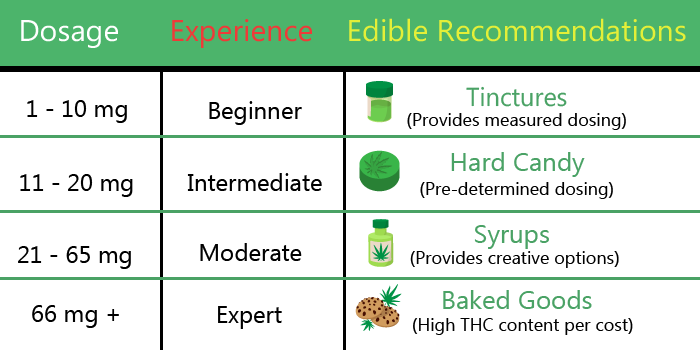Your Guide To Marijuana Edibles
Your Guide to Marijuana Edibles
Though an exact date hasn’t been set in stone, the Oregon Liquor Control Commission (OLC) will begin oversight of the recreational marijuana market in Oregon beginning in October, 2016. After several high profile cases in Colorado that prompted the United States Center for Disease Control and Prevention to call for limited portions and clear labeling, Oregon is making sure they are playing it safe. The good news is that the original slated date for beginning oversight was in February 2017. Pushing that date up means the OLC could allow for recreational sale of edibles much sooner.
Dosage: What’s the right one?
The best way to make sure you’re getting the right dose is to understand edible dosing.

A single dose is generally considered to be 10mg. For many casual users this is a great starting point. You can find a variety of products with a 10mg dosage. Tinctures typically offer the most control for beginning usage, allowing a user to easily halve or quarter the dose if they want to start out with a lower dosage. For users who already smoke on a regular basis, a single dose may not be enough to achieve the desired effects. Since it can take as long as 2-hours for the THC in an edible to take full effect, it’s still recommended to start lower and work your way upwards so you don’t exceed your comfort level.
It’s all in the packaging
In Oregon State all edibles must undergo testing at an approved facility for THC and CBD percentages and amounts before they can go to retail for medicinal consumption. Labeling and testing is already required for medicinal products according to House Bill 3460. It is unlikely more testing will be required before recreational edibles are available to consumers. Labels must contain measurements that include serving size. This is where a novice can go wrong.
Make sure you do not exceed the serving size for the dosage you are after. It may also be a good idea to make sure you have plenty of snacks in case you get hungry afterwards. Eating more of your edibles might seem like a good idea at the time, but that’s one of the quickest ways to overindulge and become too impaired.
The difference between THC and CBD
Many recreational users associate THC with marijuana. As common knowledge goes, you’ll see the letters THC in marketing materials, packaging, and emblazoned on merchandise and paraphernalia. Just because you see it more often, doesn’t mean it’s the only chemical compound you need to know. With over 480 natural compounds found in cannabis, there are 66 cannabinoids that are responsible for the effects of cannabis consumption.
These have unique effects, but generally fall into two categories—those that are psychologically active, and those that are not. THC falls under the psychologically active category, and is the most psychoactive compound in edibles.
THC is primarily responsible for: The sensation of euphoria or anxiety and paranoia, slowed reaction times, impaired memory, impaired cognitive ability, impaired coordination, altered thinking, altered physical sensation and judgement, and increased appetite.
While the severity of these effects can vary greatly from person to person, previous favorable experiences with marijuana consumption are a good indicator of positive effects from use. This isn’t true for all recreational users however, and it is possible to over-consume even with previous experience.
CBD is primarily responsible for: Reducing the negative effects of THC, suppressing seizures, reducing nausea, counteracting inflammation, fatigue, relieving physical pain, and more. While CBD has many proven positive effects, it is still being studied a great deal. Many findings have only been through a single study. While this doesn’t mean the list isn’t as long as science believes it is, it does mean ours will be a great deal shorter than many others.
Many studies have shown a correlation between THC and CBD. The positive effects of one don’t seem to work as well if the other is eliminated. Recreational users may seek marijuana edibles with a higher THC content, whereas medicinal patients often look for products with a higher CBD count.
(Edible Tip of the Day)
Since CBD’s have been found to counteract THC, a great backup plan is to keep a strictly CBD concentrate or medible on hand. If you end up taking a higher dose of THC than you intended and aren’t having a good time, consume something that only contains CBD to help reduce the effects of the THC.
Choosing your edible: Keeping with your diet, intake, and tastes.
Dietary factors: Users with gluten intolerance will not have trouble finding gluten free options. Though asking the on-staff expert at your local dispensary will yield the best results, candy typically made from sugar and flavoring (in the style of jolly ranchers) as well as tinctures will likely be gluten free and may also be vegan. These should be considered safer options, and preferred over baked goods when you are not sure.
Those with additional health concerns like diabetes or another condition that requires restricting specific ingredients already listed on non-medible packaging will be pleased to know medibles still fall under FDA guidelines. They are required to list caloric ingredients as well as THC and CBD percentages.
Intake: Many recreational users may dislike or have trouble smoking. This makes an edible a great alternative option. Tinctures are an excellent solution for intake troubles, especially when oral imbibing is also a concern. For anyone without problems chewing or smoking, there are a variety of goods that span from sweet to savory, and everything in between. Just some of the goods you should look for include:
Chocolates: A dispensary staple, infused chocolates may be even more delectable than their non-infused counterparts. Herbal chocolatiers are often small batch producers. Well you may have an easy time finding brand-name knockoffs, be prepared for just as many top-shelf chocolate bars, truffles, bon-bons, and more.
Knock-offs: They may share a similar name, but consuming oil infused knock-off gummy bears, jolly ranchers, or candy bars like the real thing will floor you quickly. Make sure you pay attention to the serving size, and don’t be afraid to divide and conquer. Half, a quarter, or even less of a full edible serving may contain 10mg or more of THC.
Liquids: From old-timey tonics to soda-pops, there is an entirely new world of marijuana enhanced beverages. These are typically lower in dosage, falling into the moderate category. Other options include tinctures which come in a variety of flavors. These are often recommended for casual use and marketed as a sleep aid. Tea is also a great option. Tea bags are typically manufactured using specific blends of indica and sativa to target certain areas of the body.
Baked Goods: Far and away the most diverse range of edibles, whether you’re looking for a standard chocolate chip cookie or something much more exotic, baked goods pack a punch. Because they typically use butter or extracts, baked goods may not be as exact as some of the previously mentioned items for dosage.
Pills: For individuals who want reliable dosing and do not want to taste their edible, capsules are perfect. These will typically contain something oil based like hash and additional oils. This is digested very quickly compared to other methods, and stores well for a long time.
Now that you know the basics, it’s just a matter of time until you get to explore the world of marijuana infused edibles for yourself. Just remember to pace yourself. You can always have another bite.
Written by: Canna Source
The post Your Guide To Marijuana Edibles appeared first on Mrs. Nice Guy.
